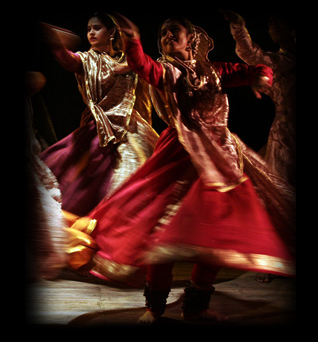SRIJAN TEERTH
THE SACRED SPACES FOR INNOVATION
This is essentially a dance journey that rediscovers the glorious period of royal patronage to arts. Spanning a period of few hundred years, we find references of many new traditions created or sustained in this period in the field of dance, music, percussion, literature, etc. SRIJAN-TEERTH is an attempt to relive some of the finest compositions or trends created in seven forts of India. The sojourn weaves together creations of three great artists and three great artist-monarchs. The dance delineation in the sequences intends to re-create the ethos of that period and the vision of the artist.
DELHI – A Dhrupad composition by Tansen set to Raag Suhaa and Jhaptaal addressing Emperor Akbar. “Shubh Mahoorat shubh Ghadi ….”
DEVGIRI FORT, Aurangabad – According to musicologists, this is the first fort in India to host a music concert. The great singer and Pakhawaj vadak Gopal Nayak was patronized by the rulers of the Yadav dynasty here. He was contemporary to Ameer Khusro and is believed to have composed many ‘prabandha’ and khyal. The com- position “Bhagya Vidhaataa…” is set to Raag Devgiri Bilaawal created by him and named after the fort.
BIJNA FORT – Situated a few kilometers away from Jhansi, Bijna Fort was rather known as a Gurukul of Pakhawaj where the Maratha King Raja Chhatrapati Singh Joodev lived the life of a devoted artist. He introduced many new and intricate concepts in the Pakhawaj repertoire. One of the most famous compositions of him, a ‘paran’ on the twelve Jyotirlingas has been included in the dance piece.
TANJORE – The contribution of Maharaja Swati Tirunal towards music is known to all. His role as musician, music composer and a patron of art has been greatly revered by practitioners of Carnatic music. One of his compositions set to Raag Vrindavani Sarang depicts a sakhi who wishes to take away Krishna from the woods.
RAIGARHA – This small territory now in Chhattisgarh is revered by the Kathak artists because of its patronage to Kathak. An accomplished Tabla artist and scholar, Raja Chakradhar Singh had invited stalwart-gurus from Lucknow and Jaipur Gharana and encouraged ‘taaleem’ of Kathak to the talented subjects. The Raigarh Gharana of Kathak showcases a beautiful blend of both the existing gharanas with the new compositions created as a result of interactions between the Gurus and few created by the king. The dance piece starts with narration of his thumri ‘Chandra badani mriga lochani ….’ followed by tukras, tihaais in teentaal. The piece concludes with ‘Dal Baadal Paran’, an abstract composition evoking the imagery of the thickening clouds of the rainy season.
AWADH – The period of Nawab Wajid Ali Shah is often known as the golden period of Kathak as it saw generous patronage to creations and sustenance of the Kathak dance art. Couplets from the ashtapadi ‘Niratata Dhanga …’ composed by Pt. Bindadin Maharaj reminds us of the guidelines of rendition to be followed by every Kathak artist.
GWALIOR – Tansen had received patronage from Tomars in Gwalior and it is believed that his art and vision was refined during this period. A dhrupad set to Raag Gurjari Todi and Sool taal addresses the Patron king and the God and glorifies his command in all the elements. The words suggest creation with elements and its celebration in both metaphysical and artistic plane.


